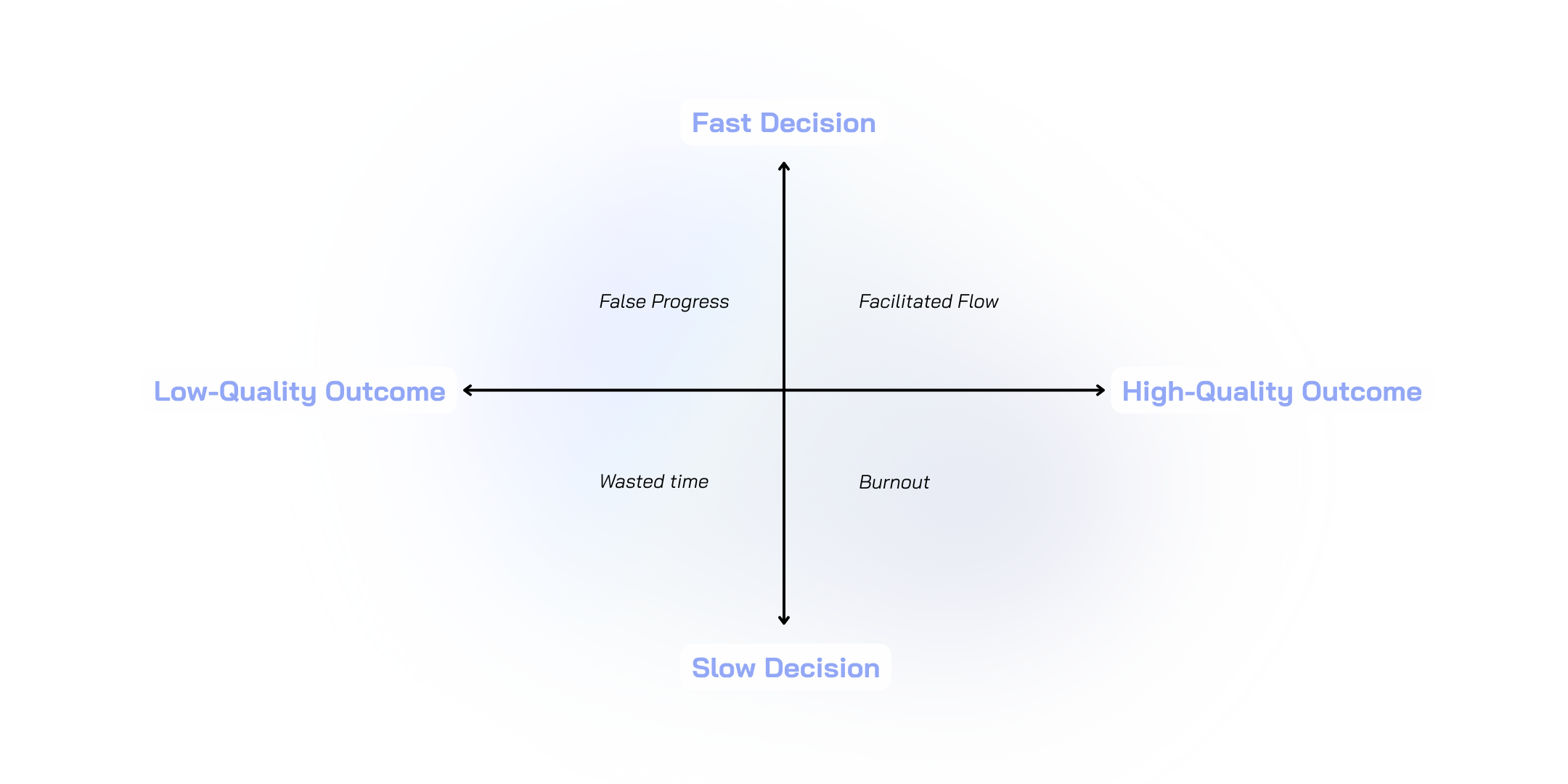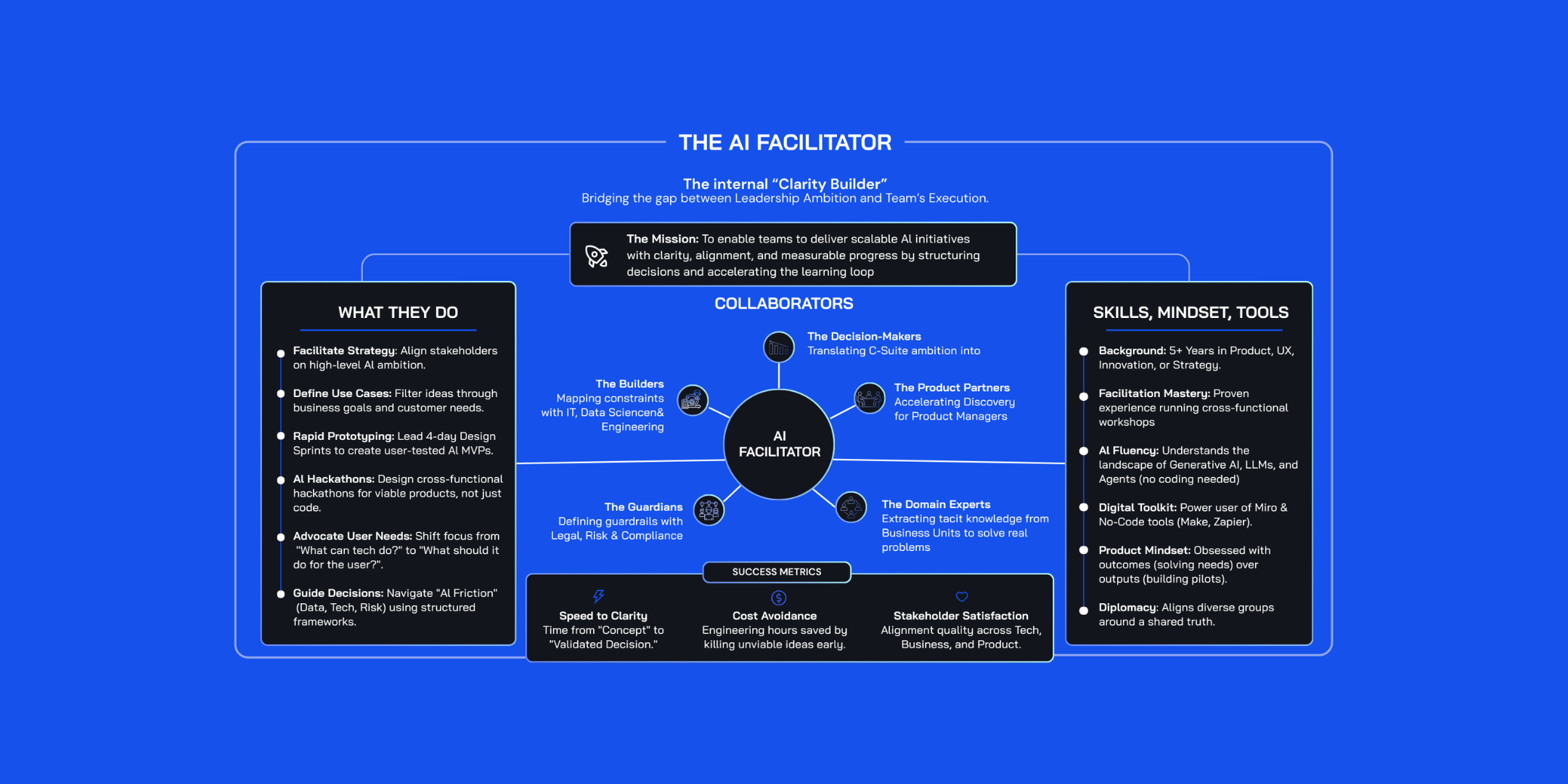Facilitation Mastery: The Skill Your AI Strategy Can’t Survive Without

In the age of AI, we’re moving faster than ever - launching initiatives, exploring agents, spinning up solutions. But beneath the speed and hype lies a much more human truth:
Progress still depends on people.
Not just individuals working hard in silos - but groups of people thinking, deciding, and moving forward together.
And that’s where most teams get stuck.
Because while AI accelerates everything, it also amplifies dysfunction - the cracks in how we collaborate, decide, and execute.
That’s why facilitation mastery isn’t a “soft skill.” It’s the system that keeps strategy from falling apart in the middle.
The problem(s)
1. We’ve normalized dysfunction and called it progress
Everyone wants to be strategic, innovative, and customer-centric. But if you’ve sat through a few (dozen) alignment meetings lately, you know the reality:
- Teams talk at each other instead of with each other
- Cross-functional means “confused,” not “collaborative”
- Decisions are postponed, then made in backchannels
- Great ideas die because the group couldn’t agree, or didn’t hear them at all
- Endless iteration loops, where the teams debate instead of finding ways to learn fast
- Teams stay polite, even when they should challenge assumptions. People protect egos, not outcomes.
- Workshops are just theatre. Sticky notes, screenshots, excitement… and then silence. Three weeks later, nothing has changed.
- People don’t lead conversations with customer insights and data.
We’ve simply normalized the back and forth — and called it progress.
And most people don’t even realize how bad it’s gotten.
It happened slowly...
- First, one meeting runs long - and no one objects.
- Then, another one ends without decisions - but everyone’s calendar is already full.
- Then, the HIPPO talks, and no one else does.
- Eventually, no one expects meetings to do anything anymore.
We’ve normalized dysfunction and lowered the bar for collaboration. And here’s the scary part: most teams don’t even imagine that it could be different. They believe this is what collaboration looks like — that dysfunction is just the cost of doing business.
But when the world moves at AI speed, that level of dysfunction becomes fatal. You don’t have months to align. You have days.
If you were to map out today’s collaboration across two axes — how fast decisions are made and how high-quality the outcomes are — you get this:
⬅️ Slow Decision + Low-Quality Outcome = Wasted Time
- Long, painful meetings. Endless discussion, no progress. Teams leave drained — and nothing meaningful changes.
➡️ Fast Decision + Low-Quality Outcome = False Progress
- Quick calls made without context, data or alignment. Momentum without direction. You’re moving… but toward the wrong thing.
⬅️ Slow Decision + High-Quality Outcome = Burnout
- You eventually get something good — but at the cost of morale, delays, and frustration. Not sustainable.
➡️ Fast Decision + High-Quality Outcome = Facilitated Flow
- Clear, aligned decisions made quickly — grounded in collective knowlege and expertise and data. You get results and team energy.

Facilitation mastery is what raises the standard again.
It’s the antidote to dysfunction — replacing “talking time” with structure, meetings with movement, and opinions with evidence.
2. We put visionaries in charge — but gave them no system
Then there’s the opposite problem.
The company hires or promotes the brave ones — the change agents, the challengers, the boundary-pushers. The ones who see where things could go.
And then?
They’re dropped into an organization that’s not ready for them.
They walk in full of energy — ready to break silos, challenge assumptions, and ignite transformation — only to hit a wall of inertia and fear.
They want to open the dialogue between business, tech, and design.
They want to connect strategy to execution.
But the system around them is designed for compliance, not collaboration.
The result?
- The visionary becomes the outsider
- Their ideas become “too disruptive”
- People nod politely, then do nothing
- Eventually, they stop pushing — or they leave
And the organization learns the wrong lesson: that innovation is risky, that change doesn’t work here, that “people just don’t get it.”
But it’s not that people don’t get it.
It’s that we don’t give visionaries the tools, frameworks, and facilitation systems they need to bring others along.
Change can’t happen to people — it has to happen with them.
And facilitation is the bridge between the visionary’s intent and the organization’s ability to act.
Facilitation mastery gives leaders the structure and language to lead change — not by force, but by participation.
Facilitation Mastery: The DSA Perspective
At DSA, we’ve seen this across hundreds of teams, industries, and countries: when facilitation is missing, everything slows down. When it’s mastered, everything changes.
Facilitation mastery is about turning methods into an organizational capability.
It’s the ability to:
- Surface insight fast — without endless meetings
- Make decisions with evidence, not hierarchy
- Align silos without politics
- Bring expertise into the room — and make it work together
- Create momentum that lasts after the workshop
We call it structured collaboration at scale.
But how do you actually teach facilitation mastery? How do you turn “soft skills” into a replicable system that delivers results — especially in high-stakes, AI-driven work?
What Makes Our System Work
Here are three key components that make facilitation mastery stick — and scale — inside modern organizations:
💡 The Mindset We Teach: Focus on Results
You’ve probably heard this before: “you’re the guide, not the hero.” It’s good advice — but only halfway true. Taken too literally, it teaches detachment. It lets facilitators off the hook when the outcome misses the mark.
At DSA, we teach a different mindset: you’re not the hero of the story, but you’re absolutely accountable for how it ends. Your role is to design the conditions for success — and ensure the team gets where it needs to go.
One of the biggest myths in facilitation is that your job is just to “hold space.” That’s not enough. If a team walks away from your workshop saying: “Well, that was fun… but we’re not sure what to do next.” — that’s a failure of design, not just delivery.
We train facilitators to take ownership of outcomes — not by dictating, but by obsessing over clarity, flow, and results. The question isn’t, “Did they enjoy the session?” It’s: “Did they get what they needed to move forward?”
🧭 The Value We Teach: Start from Where People Are
Every workshop begins before it begins.
If you don’t understand your participants — their perspective, their context, their resistance — you’re flying blind.
That’s why we emphasize pre-workshop stakeholder interviews as a core part of facilitation mastery. You need to know:
- Where are people now?
- What do they believe?
- What blind spots or tensions already exist?
- What needs to shift for this session to be useful?
Facilitators aren’t just neutral parties — they’re designers of meaningful conversations. And great design starts with insight.
📊 The Extra Mile We Insist On: Get the Data
You can’t align a room if no one knows what’s true.
That’s why we teach facilitators to do their homework. Before you walk in, ask:
- What’s fact vs assumption?
- What’s opinion vs insight?
- What’s been tested vs what’s just buzz?
Chances are, someone in the org already knows something important — a research nugget, a spreadsheet, a KPI that changes the direction. It’s your job to find it.
Data doesn’t slow you down — it speeds up alignment.
Facilitation Mastery Isn’t Magic. It’s Method.
We don’t treat facilitation as a side skill or bonus talent.
We train facilitators to:
- Navigate conflict with confidence
- Lead high-stakes sessions with structure
- Turn workshops into decisions and momentum
- Apply facilitation to AI, strategy, and innovation work
- Design conversations that surface insight, not politics
We’ve seen it work — with AI teams, strategy teams, product orgs, innovation hubs, and more.
In the AI Era, Facilitation Is How You Stay Human
AI will automate many things — but it can’t replace the conversations that define direction, trust, and creativity.
Facilitation mastery keeps those conversations productive, focused, and forward-moving — especially when stakes are high and uncertainty is everywhere.
It’s what makes complexity manageable.It’s what makes innovation real.It’s what makes strategy executable.
Don’t wait for clarity. Facilitate it. Get things done.
Let’s talk about building your internal capability!


.jpg)
.png)





